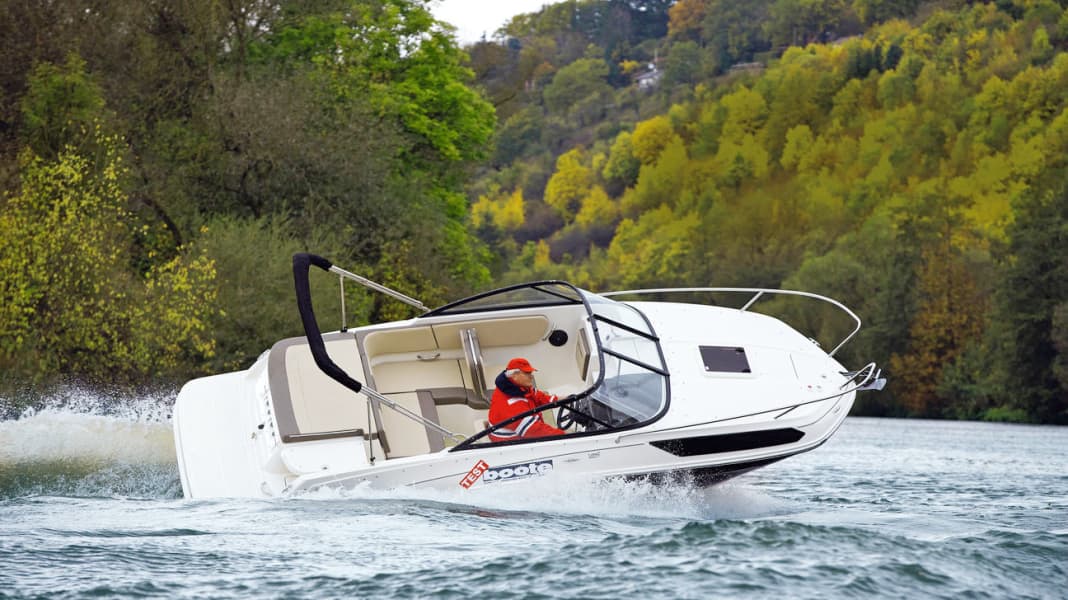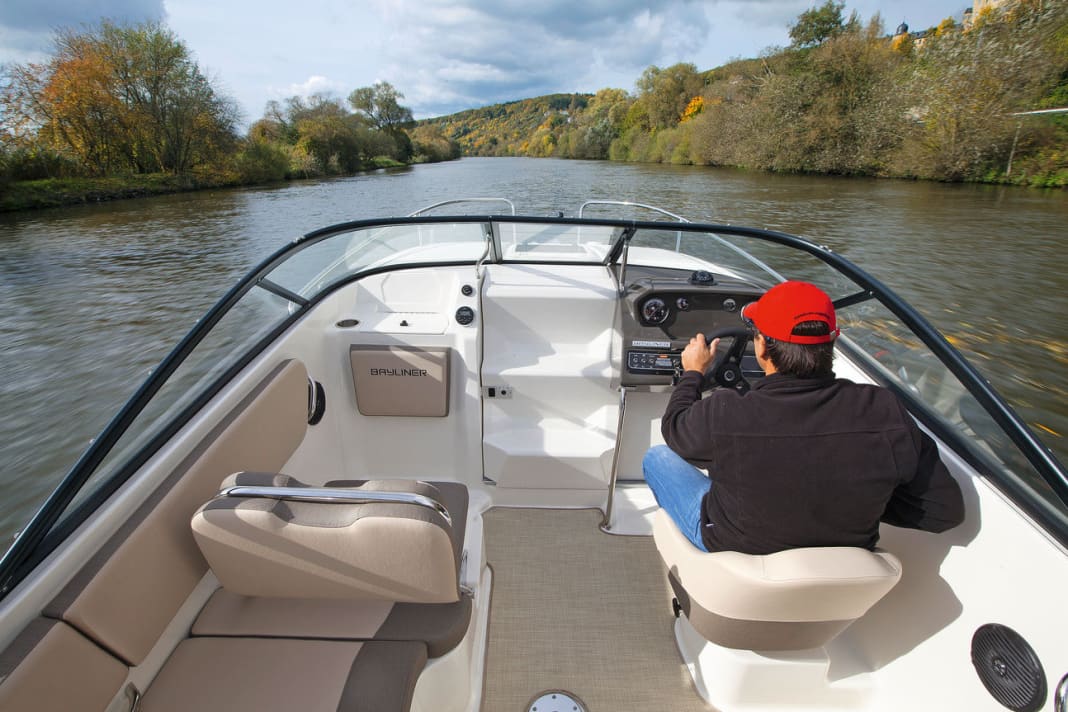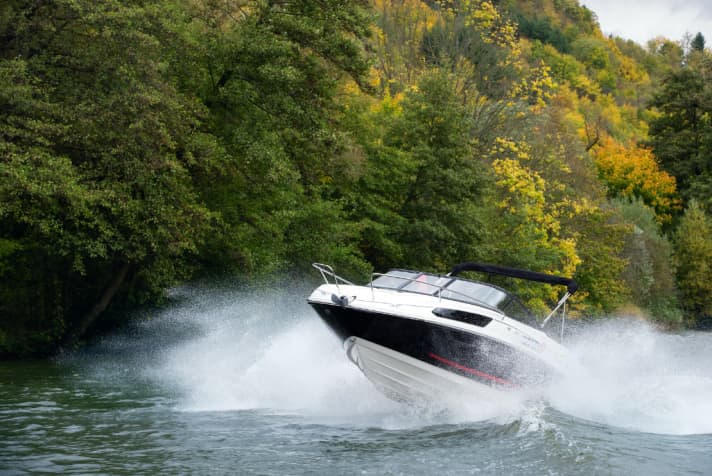






You don't always have to reinvent the wheel. That's what car manufacturers and, increasingly, boat builders think when developing new models.the so-called platform principle set. Various models are built on a technical basis, i.e. the hull in the case of a boat. Bayliner uses this principle for the VR5, which is not only available as a day cruiser as in our test, but also as a bowrider with the same hull and different superstructure (see also Boats 3/2016).
As a special feature, you can choose between a built-in or outboard motor. The outboard motor hangs on a device attached to the stern behind the bathing platform - also known as a bracket.
The advantage:The platform remains intact, and the space for the built-in engine then serves as storage space. We drive the boat with a V6 petrol MerCruiser with catalytic converter, a 170 hp diesel is optional. In terms of overall workmanship, our test boat leaves a good impression.consistently good impression. If you want to transport the boat over land, you need a towing vehicle that can take at least 2200 kg on the hook.
Driving and manoeuvring
Full circles measure a maximum of one and a half boat lengths at low speed (700 rpm) with both forward and reverse gears engaged,which simplifies manoeuvring in confined spaces. The VR5 is also easy to navigate when travelling astern. When travelling slowly ahead (4 knots), weight shifts in the boat are noticeable in terms of course and heeling.Waves generated by the boat remain at an acceptable altitude up to 6 knots or 1500 rpm.
The transition from displacement to planing speed is associated with a brief obstruction of visibility. Without delay, the 200 hp V6 accelerates our test boat up to amaximum speed of just over 40 knots. The fact that the motor turns 50 rpm more than the manufacturer allows is due to the low load condition and is evidence of a suitable propeller.
We measure the acceleration from zero to 40 knots at 14.1 seconds and the lowest glide speed at 16 knots.
After analysing our measured values, we found that the test boat is most economical at a speed of 22 knots and 3000 rpm in fast planing mode. One tank of fuel is then sufficient for a theoretical range of 101 nm plus 15 % reserve.
Target fulfilled, grade good.
At full throttle you should look for a bunker station after around 70 nm, and at slow speed you can allow yourself around 9 nm more before you run out of reserves.
For the extreme manoeuvres performed at maximum speed, we measure the turn diameters over port to be smaller than those over starboard. And while the 180° turn over port is performed in one go without rocking or hooking the hull, the same manoeuvre over starboard involves a few extra rocking movements.
However, the resulting centrifugal forces are still within the green range, as confirmed by our measuring device. When travelling on the imaginary slalom course, we safely cause the test boat to oscillate over its longitudinal axis, and when the rudder is pulled away, it follows the chosen course without complaint.
The increasingly tighter curvesdrives through the VR5 without much fuss. Only over the port side, as the bend is tighter, does our MerCruiser howl briefly at the narrowest point because the aluminium propeller briefly reaches into the void, but without completely losing its grip. No waves or rough water. Only the commercial shipping produces a few waves, but they don't pose a major challenge to the Bayliner's hull.
Overall, the VR5 Cuddy conveys a positive feeling throughout the test sequences and earns a "good" rating for its handling characteristics.

Only theDriver's seat is more for slim butts has been designed. The side bolsters of the seat shell are uncomfortable for heavier people. In addition, the backrest is quite short and tilted too far aft. Furthermore, the seat cannot be pushed far enough forwards to reach the steering easily. Meanwhile, the front passenger sits on the convertible cockpit L-shaped bench seat without any major loss of comfort.
However, the volume level is also a problem. At 4000 rpm, our sound pressure level meter already shows 85 dB/A - with an increasing tendency.
The skipper's workplace appears tidy,There is still room for electronics next to the analogue instruments. The depth sounder and windscreen wiper cost extra, and it is not clear whether the compass is included or not. The reflections in the windscreen are annoying.
Technology and safety
If you want to lift the engine compartment lid, you have to remove the cushions from the rear bench seat and fold down the lid from the starboard aft passage. You will then see aMotor that can be easily accessed from all sidesas well as the rear part of the fuel tank.
The water tank, battery and main fuses are located on the port side. The remaining fuses are less easily accessible under the dashboard, while the main battery switch is located in the storage compartment of the port bench seat.
Minus: There is no fuel tap and you have to rely on the engine manufacturer to clean the fuel.
A hand bilge pump is also missing. But there is aAutomatic fire extinguisher in the engine compartmentThe boat is equipped with a cleanly laid technology and protected bulkhead openings as well as a self-draining cockpit outboard.
Day and night
The first way into the boat is via the entrance at the stern, the second via the foredeck, folding windscreen and steps in the sliding cabin door.
"Day cruiser" means that the focus is on the day. In any case, the cockpit is designed in accordance with CE with a plug-in table, swivelling skipper's chair and convertible L-shaped bench seat.Space for up to eight people to sit on. Two people can spend the night in the cabin if the V-shaped bench seat is converted into a lounger by inserting boards and cushions.
Moderate standard equipment offerscreative freedom for many extraswhich are bundled in packages. We are missing the navigation lights approved in Germany, a tarpaulin and a soft top, which we devalue.
Although there are six mooring cleats, the two at the bow are difficult to take from the jetty.
TheSufficient storage spaceThe boat also has towing eyes fore and aft and a water ski hook above the platform. The standard anchor locker at the front can be equipped with an electric winch, chain and other accessories for an additional charge.
You have to get used to the foredeck, which slopes forwards, and it's better to only move there bent over because of the low railing. But it offersEnough space for sunbathing.
CONCLUSION
The VR5 Cuddy is ideal for short holidays with a trailer, short jaunts and also for water sports enthusiasts if they take the extra list into account. The workmanship is impressive.


